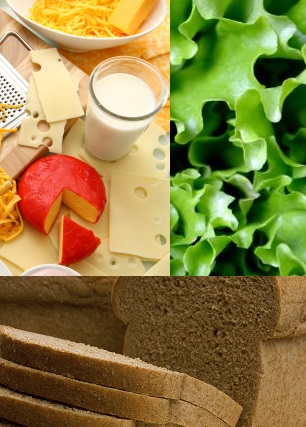Riboflavin - Vitamin B2
Riboflavin (Vitamin B2)

Who doesn't get enough
In general, people who live in developed countries like the U.S. get enough nutrients, including Vitamin B2. However, those with eating disorders or who live in poverty may not eat enough food to get sufficient Vitamin B2 in their diet.
If you pursue a vegan or vegetarian diet, or you are lactose-intolerant and do not eat dairy products, you should eat more dark, leafy vegetables and grain products that are whole or enriched.
Destroyed by Light
Vitamin B2 is destroyed by light and irradiation, but not by cooking. This is of particular interest now, because the government is thinking of irradiating all fresh produce to kill germs.
Summary
You know that all of the vitamins work together to keep you healthy and feeling good. Here is a summary of the role of Vitamin B2, a water-soluble vitamin, in your good health.
If you eat a variety of foods from all of the food groups, you will probably get enough nutrients, including Vitamin B2.
Athletes and heavy laborers will need a slightly higher amount of riboflavin in their diets, since these activities may deplete it. There is also some evidence that this B vitamin may by useful in alleviating migraine headaches.
Caveat: Alcoholics are at particular risk for Vitamin B2 deficiency, since alcohol inhibits the ability of the body to absorb and use Vitamin B2 This means that even if an alcoholic is eating lots of dairy products, the body may not have access to enough of this B vitamin to maintain good health. If alcohol is replacing food in the diet, there could also be a deficiency.
| What it does | Functions as a coenzyme to help release energy from the food you eat |
| Daily needs | [Infants*: .3-.4 mg] [Children†: .5-1.3 mg] [Men: 1.3 mg] [Women: 1.1 mg] [Pregnant: 1.4 mg] [Lactating: 1.6 mg] |
| Not enough | Sore mouth/throat, Inflamed eyes, Skin inflammation,Inflamed digestive tract, Impaired iron absorption Severe - Ariboflavinosis |
| Too Much | No known toxicity effects |
| Foods | Milk and other dairy products, Dark green, leafy vegetables, Whole or enriched grain products |
*The lower value is for infants up to 6 mos.,higher value is for infants up to a year old.
† The first value is for children 1-3 with the amount increasing until age 18.

